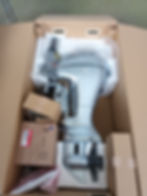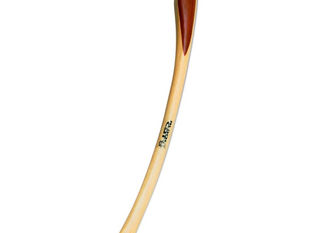
The Honda outboard was my present for my father’s 78th birthday. Last summer saw its first Danube use and it was locally proclaimed the best thing for a dinghy such as my father’s. The opinion was unanimously voiced as soon as Stanevo’s fishing community saw it at the village river port. Subsequent discussions at the 9 a.m. gatherings at Milka’s coffee-shop went on praising the motor’s reliability as well as its very smooth and economic performance. Indeed, compared to previous two-stroke engines, this 10 hp 4-stroke machine could do a daily fishing trip on a coffee-cup of petrol.

By the end of Season ’24, the Honda had clocked 25 hours of work, including the first ten for breaking in. All in all, by the end of the season it was as good as new. Consequently, hardly anything had to be done to get it ready for the new season, apart from replacing the engine-oil, and checking on the gear-oil. By 16 May, the outboard was serviced and proclaimed by Rosen to be fully ready for use.

Meanwhile, other preparations went on. The list there was long. Number one priority was a wood-burning cooking-range to replace the old one.

After ten years of being carried back-and-forth from Sofia to the camp, it had finally gasped its last breath. A smaller and lighter stove was found in the second-hand ad internet market and duly sent to us by courier from some village in Northern Bulgaria. It looked quite convincing, so my father betted on it for the summer.
Another lighter and more compact improvement for the dining-room, kitchen, and office – all of them plus my father’s bedroom under the big tent’s roof – were two collapsible racks with shelves. One of them would go for pots, plates, glasses, etc., the other was needed for the invertor and controller of the solar panels, books, medicine-box, sewing-box, tool-boxes, etc. Previously, these racks had been made by my father from poles and planks, but they turned out to be too bulky and heavy, particularly when it came to transporting them by boat. After a decade of use, their turn also came to be replaced by less unwieldy structures.

Next on the list came the camera-traps, and, in addition, a bird-feeder with a camera inside. This gadget list was completed with a sound-recorder for recording jackal howling as well as other jackal vocalizations (growling, shouting, ‘cackling’, etc.). Each one of the gadgets had its own needs.
The camera-traps were the work-horses of research so they needed special care. What that amounted to were fresh rechargeable batteries, as the old ones had been charged and discharged so many times that they could not be trusted to hold power for more than a night or two. There were three cameras altogether. Two of these would be trained on the bait-site and a third positioned further away in the vicinity of the birthing den. Of the three, one had a small solar panel to charge its two very exotic batteries. These had to be replaced, for the same reason as the others. The remaining two used 8 AA batteries each, so that meant 16 new batteries, plus the two exotic ones.
That was about batteries, but one needed SD cards also for the recorded material. My father would extract these from the cameras each morning and insert them into his laptop for processing. In the evening, they would be put back into the cameras. That would be done every day for the duration of the season, usually lasting around 90 days.
Luckily SD cards may last seemingly forever, so the only thing that had to be done was to get a mini-SD for the bird-watching camera, and an adapter for it, so it could be downloaded to the laptop. This last bit meant that a new external memory had to be bought, as the previous two were full of pics and clips by now. My brother Kolyo took care of this part, ordering a 2 TB external memory. He was also carrying on the fight with the smart bird-feeder as that particular nut proved hard to crack. One needed to register and pre-view the recorded videos on their smart phones. My father was an off-grid man, adamant about not succumbing to a smart phone. I have learnt that this rock I cannot move. I'll have to go around it and hopefully find a different solution.
Two previous sound-recorders had been damaged by rain and thunder-storms, so a new one had to be bought. We decided upon a very simple SONY model, not wishing to risk anything more expensive in the summer storms which were becoming increasingly frequent and violent. The summer will show whether we had been right.
In the way of gadgets, the last one was a small Canon digital camera. Luckily, its rechargeable battery was still good, and it already had a SD-card. The only thing there was not to leave behind its battery-charger.
Then came the power-sources. There were three groups of such, each one with its own particular needs. First came two solar panels of 300 watts each. The cables coming from them went to a controller, and from it, simultaneously to an invertor and two Banner track batteries. The whole system provided enough power to charge the laptop battery, camera-trap and sound-recorder rechargeable AA batteries (eight for each one of the camera-traps), Canon camera, and mobile-phone batteries.

In addition to powering all the necessary gadgets, the solar panels kept going a combined propane and electricity fridge-box. That is, it used electricity from the panels during day-time, shifting to gas during the night.
Of the whole solar power plant, only the batteries needed re-charging to keep them from going flat.

Compressed propane-butane 25 kg cylinders thus provided the second important source of energy. Apart from cylinder connected to the fridge-box, a second one was used for a gas-ring. That saved my father the trouble of lighting the wood-burning stove for quick tasks. Like when brewing coffee, or boiling rice, and such.
The third power source was a Honda 2 Kw electric generator. My father used it when pumping water from the river, or when some electric too had to be used – like a drill, an angle-grinder, or a screw-driver. The generator also served as an emergency source of power. To get it ready for the summer it only needed changing of the engine-oil, a task soon done.
All these tasks seen to – gas cylinders filled up, track batteries charged, all engines serviced – the whole equipment was put on palettes, ready for loading onto the factory van. Departure was set for 24 May.






